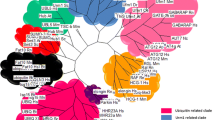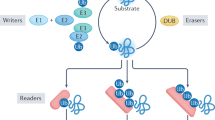Abstract
Deubiquitinating enzymes (DUBs) are active at multiple levels of the eukaryotic ubiquitin system. DUBs are important for ubiquitin activation and maintaining cellular ubiquitin levels but can also edit or dissolve ubiquitin chains or deconjugate ubiquitin from substrates. Eukaryotic DUBs can be grouped into seven molecular classes, most of which enzymes are cysteine proteases assuming the papain fold. In recent years, an ever-increasing number of pathogen-encoded DUBs have been characterized, which are active inside the host cell and help the pathogens to evade the defense response. At first sight, bacterial and viral DUBs appear to be very different from their eukaryotic counterparts, making them hard to identify by bioinformatic methods. However, apart from very few exceptions, bacterial and viral DUBs are distantly related to eukaryotic DUB classes and possess several hallmarks that can be used to identify high-confidence DUB candidates from pathogen genomes – even in the complete absence of biochemical or functional annotation. This chapter addresses bioinformatical DUB discovery approaches based on a previously published analysis of DUB evolution. The core set of bioinformatical tools required for this endeavor are freely accessible and do not require a particular bioinformatics infrastructure.
Access this chapter
Tax calculation will be finalised at checkout
Purchases are for personal use only
Similar content being viewed by others
References
Rape M (2018) Ubiquitylation at the crossroads of development and disease. Nat Rev Mol Cell Biol 19(1):59–70. https://doi.org/10.1038/nrm.2017.83
Clague MJ, Urbe S, Komander D (2019) Breaking the chains: deubiquitylating enzyme specificity begets function. Nat Rev Mol Cell Biol 20(6):338–352. https://doi.org/10.1038/s41580-019-0099-1
Hermanns T, Hofmann K (2019) Bacterial DUBs: deubiquitination beyond the seven classes. Biochem Soc Trans 47(6):1857–1866. https://doi.org/10.1042/BST20190526
Proulx J, Borgmann K, Park IW (2021) Role of virally-encoded deubiquitinating enzymes in regulation of the virus life cycle. Int J Mol Sci 22(9). https://doi.org/10.3390/ijms22094438
Borodovsky A, Ovaa H, Kolli N, Gan-Erdene T, Wilkinson KD, Ploegh HL, Kessler BM (2002) Chemistry-based functional proteomics reveals novel members of the deubiquitinating enzyme family. Chem Biol 9(10):1149–1159
Scheel H, Tomiuk S, Hofmann K (2003) Elucidation of ataxin-3 and ataxin-7 function by integrative bioinformatics. Hum Mol Genet 12(21):2845–2852. https://doi.org/10.1093/hmg/ddg297
Maytal-Kivity V, Reis N, Hofmann K, Glickman MH (2002) MPN+, a putative catalytic motif found in a subset of MPN domain proteins from eukaryotes and prokaryotes, is critical for Rpn11 function. BMC Biochem 3:28. https://doi.org/10.1186/1471-2091-3-28
Hermanns T, Woiwode I, Guerreiro RF, Vogt R, Lammers M, Hofmann K (2020) An evolutionary approach to systematic discovery of novel deubiquitinases, applied to Legionella. Life Sci Alliance 3(9). https://doi.org/10.26508/lsa.202000838
Hermanns T, Pichlo C, Woiwode I, Klopffleisch K, Witting KF, Ovaa H, Baumann U, Hofmann K (2018) A family of unconventional deubiquitinases with modular chain specificity determinants. Nat Commun 9(1):799. https://doi.org/10.1038/s41467-018-03148-5
Abdul Rehman SA, Kristariyanto YA, Choi SY, Nkosi PJ, Weidlich S, Labib K, Hofmann K, Kulathu Y (2016) MINDY-1 is a member of an evolutionarily conserved and structurally distinct new family of deubiquitinating enzymes. Mol Cell 63(1):146–155. https://doi.org/10.1016/j.molcel.2016.05.009
Finn RD, Mistry J, Tate J, Coggill P, Heger A, Pollington JE, Gavin OL, Gunasekaran P, Ceric G, Forslund K, Holm L, Sonnhammer EL, Eddy SR, Bateman A (2011) The Pfam protein families database. Nucleic Acids Res 38(Database issue):D211–D222
Hunter S, Apweiler R, Attwood TK, Bairoch A, Bateman A, Binns D, Bork P, Das U, Daugherty L, Duquenne L, Finn RD, Gough J, Haft D, Hulo N, Kahn D, Kelly E, Laugraud A, Letunic I, Lonsdale D, Lopez R, Madera M, Maslen J, McAnulla C, McDowall J, Mistry J, Mitchell A, Mulder N, Natale D, Orengo C, Quinn AF, Selengut JD, Sigrist CJ, Thimma M, Thomas PD, Valentin F, Wilson D, Wu CH, Yeats C (2009) InterPro: the integrative protein signature database. Nucleic Acids Res 37(Database issue):D211–D215
Schubert AF, Nguyen JV, Franklin TG, Geurink PP, Roberts CG, Sanderson DJ, Miller LN, Ovaa H, Hofmann K, Pruneda JN, Komander D (2020) Identification and characterization of diverse OTU deubiquitinases in bacteria. EMBO J 39(15):e105127. https://doi.org/10.15252/embj.2020105127
Pruneda JN, Durkin CH, Geurink PP, Ovaa H, Santhanam B, Holden DW, Komander D (2016) The molecular basis for ubiquitin and ubiquitin-like specificities in bacterial effector proteases. Mol Cell 63(2):261–276. https://doi.org/10.1016/j.molcel.2016.06.015
Bailey-Elkin BA, Knaap RCM, Kikkert M, Mark BL (2017) Structure and function of viral deubiquitinating enzymes. J Mol Biol 429(22):3441–3470. https://doi.org/10.1016/j.jmb.2017.06.010
Zong Z, Zhang Z, Wu L, Zhang L, Zhou F (2021) The functional deubiquitinating enzymes in control of innate antiviral immunity. Adv Sci (Weinh) 8(2):2002484. https://doi.org/10.1002/advs.202002484
Gastaldello S, Hildebrand S, Faridani O, Callegari S, Palmkvist M, Di Guglielmo C, Masucci MG (2010) A deneddylase encoded by Epstein-Barr virus promotes viral DNA replication by regulating the activity of cullin-RING ligases. Nat Cell Biol 12(4):351–361. https://doi.org/10.1038/ncb2035
Schlieker C, Weihofen WA, Frijns E, Kattenhorn LM, Gaudet R, Ploegh HL (2007) Structure of a herpesvirus-encoded cysteine protease reveals a unique class of deubiquitinating enzymes. Mol Cell 25(5):677–687. https://doi.org/10.1016/j.molcel.2007.01.033
Jumper J, Evans R, Pritzel A, Green T, Figurnov M, Ronneberger O, Tunyasuvunakool K, Bates R, Zidek A, Potapenko A, Bridgland A, Meyer C, Kohl SAA, Ballard AJ, Cowie A, Romera-Paredes B, Nikolov S, Jain R, Adler J, Back T, Petersen S, Reiman D, Clancy E, Zielinski M, Steinegger M, Pacholska M, Berghammer T, Bodenstein S, Silver D, Vinyals O, Senior AW, Kavukcuoglu K, Kohli P, Hassabis D (2021) Highly accurate protein structure prediction with AlphaFold. Nature 596(7873):583–589. https://doi.org/10.1038/s41586-021-03819-2
Altschul SF, Gish W, Miller W, Myers EW, Lipman DJ (1990) Basic local alignment search tool. J Mol Biol 215(3):403–410. https://doi.org/10.1016/S0022-2836(05)80360-2
Potter SC, Luciani A, Eddy SR, Park Y, Lopez R, Finn RD (2018) HMMER web server: 2018 update. Nucleic Acids Res 46(W1):W200–W204. https://doi.org/10.1093/nar/gky448
Katoh K, Standley DM (2013) MAFFT multiple sequence alignment software version 7: improvements in performance and usability. Mol Biol Evol 30(4):772–780. https://doi.org/10.1093/molbev/mst010
Waterhouse AM, Procter JB, Martin DM, Clamp M, Barton GJ (2009) Jalview Version 2–a multiple sequence alignment editor and analysis workbench. Bioinformatics 25(9):1189–1191. https://doi.org/10.1093/bioinformatics/btp033
Soding J (2005) Protein homology detection by HMM-HMM comparison. Bioinformatics 21(7):951–960. https://doi.org/10.1093/bioinformatics/bti125
Zimmermann L, Stephens A, Nam SZ, Rau D, Kubler J, Lozajic M, Gabler F, Soding J, Lupas AN, Alva V (2018) A completely reimplemented MPI bioinformatics toolkit with a new HHpred server at its core. J Mol Biol 430(15):2237–2243. https://doi.org/10.1016/j.jmb.2017.12.007
Baek M, DiMaio F, Anishchenko I, Dauparas J, Ovchinnikov S, Lee GR, Wang J, Cong Q, Kinch LN, Schaeffer RD, Millan C, Park H, Adams C, Glassman CR, DeGiovanni A, Pereira JH, Rodrigues AV, van Dijk AA, Ebrecht AC, Opperman DJ, Sagmeister T, Buhlheller C, Pavkov-Keller T, Rathinaswamy MK, Dalwadi U, Yip CK, Burke JE, Garcia KC, Grishin NV, Adams PD, Read RJ, Baker D (2021) Accurate prediction of protein structures and interactions using a three-track neural network. Science 373(6557):871–876. https://doi.org/10.1126/science.abj8754
Holm L (2019) Benchmarking fold detection by DaliLite v.5. Bioinformatics 35(24):5326–5327. https://doi.org/10.1093/bioinformatics/btz536
Wan M, Wang X, Huang C, Xu D, Wang Z, Zhou Y, Zhu Y (2019) A bacterial effector deubiquitinase specifically hydrolyses linear ubiquitin chains to inhibit host inflammatory signalling. Nat Microbiol 4(8):1282–1293. https://doi.org/10.1038/s41564-019-0454-1
Acknowledgments
This work was supported by the DFG grant HO 3783/3-1.
Author information
Authors and Affiliations
Corresponding author
Editor information
Editors and Affiliations
Rights and permissions
Copyright information
© 2023 The Author(s), under exclusive license to Springer Science+Business Media, LLC, part of Springer Nature
About this protocol
Cite this protocol
Hermanns, T., Hofmann, K. (2023). Bioinformatical Approaches to the Discovery and Classification of Novel Deubiquitinases. In: Maupin-Furlow, J., Edelmann, M.J. (eds) Deubiquitinases. Methods in Molecular Biology, vol 2591. Humana, New York, NY. https://doi.org/10.1007/978-1-0716-2803-4_9
Download citation
DOI: https://doi.org/10.1007/978-1-0716-2803-4_9
Published:
Publisher Name: Humana, New York, NY
Print ISBN: 978-1-0716-2802-7
Online ISBN: 978-1-0716-2803-4
eBook Packages: Springer Protocols




